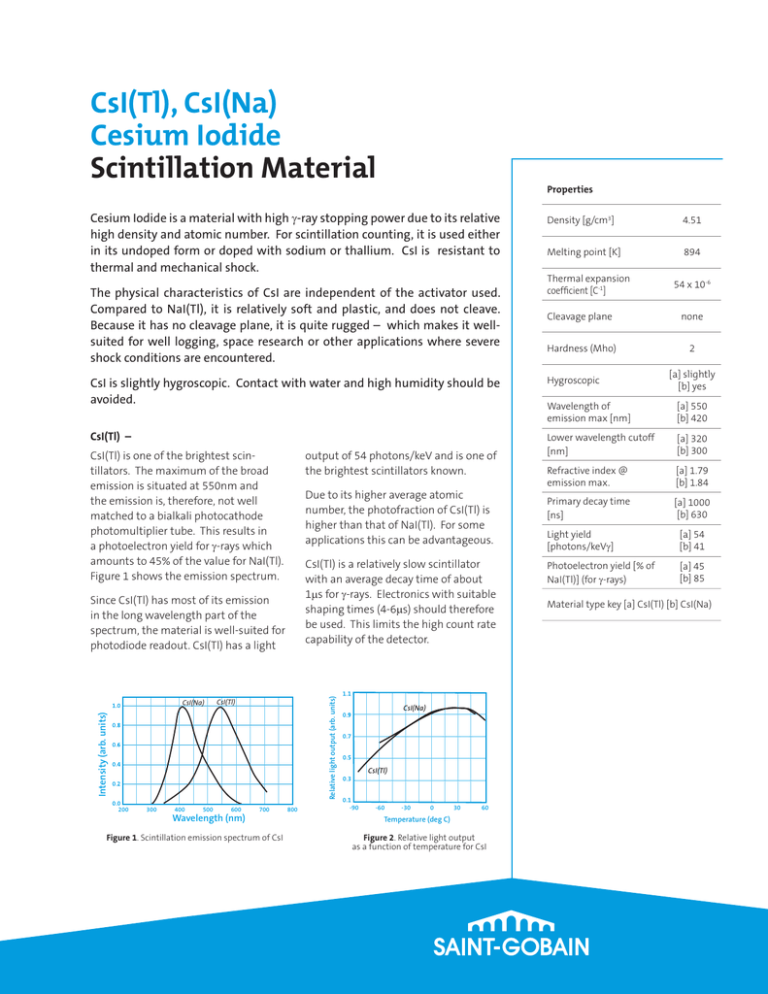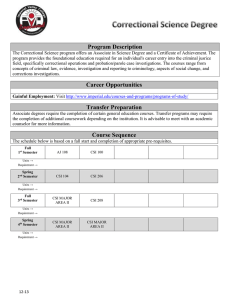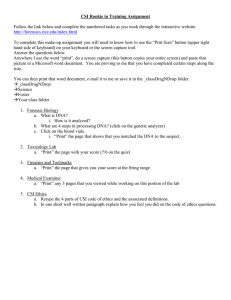
CsI(Tl), CsI(Na)
Cesium Iodide
Scintillation Material
Properties
Cesium Iodide is a material with high γ-ray stopping power due to its relative
high density and atomic number. For scintillation counting, it is used either
in its undoped form or doped with sodium or thallium. CsI is resistant to
thermal and mechanical shock.
The physical characteristics of CsI are independent of the activator used.
Compared to NaI(Tl), it is relatively soft and plastic, and does not cleave.
Because it has no cleavage plane, it is quite rugged – which makes it wellsuited for well logging, space research or other applications where severe
shock conditions are encountered.
Density [g/cm3]
4.51
Melting point [K]
894
Thermal expansion
coefficient [C-1]
54 x 10-6
Cleavage plane
none
Hardness (Mho)
2
[a] slightly
[b] yes
CsI is slightly hygroscopic. Contact with water and high humidity should be
avoided.
Hygroscopic
Wavelength of
emission max [nm]
[a] 550
[b] 420
CsI(Tl) –
Lower wavelength cutoff
[nm]
[a] 320
[b] 300
Refractive index @
emission max.
[a] 1.79
[b] 1.84
Primary decay time
[ns]
[a] 1000
[b] 630
output of 54 photons/keV and is one of
the brightest scintillators known.
CsI(Tl) is one of the brightest scintillators. The maximum of the broad
emission is situated at 550nm and
the emission is, therefore, not well
matched to a bialkali photocathode
photomultiplier tube. This results in
a photoelectron yield for γ-rays which
amounts to 45% of the value for NaI(Tl).
Figure 1 shows the emission spectrum.
Due to its higher average atomic
number, the photofraction of CsI(Tl) is
higher than that of NaI(Tl). For some
applications this can be advantageous.
CsI(Tl) is a relatively slow scintillator
with an average decay time of about
1µs for γ-rays. Electronics with suitable
shaping times (4-6µs) should therefore
be used. This limits the high count rate
capability of the detector.
CsI(Tl)
Intensity (arb. units)
CsI(Na)
Relative light output (arb. units)
Since CsI(Tl) has most of its emission
in the long wavelength part of the
spectrum, the material is well-suited for
photodiode readout. CsI(Tl) has a light
200
300
400
500
600
Wavelength (nm)
700
Figure 1. Scintillation emission spectrum of CsI
800
CsI(Na)
CsI(Tl)
-90
-60
-30
0
30
60
Temperature (deg C)
Figure 2. Relative light output
as a function of temperature for CsI
Light yield
[photons/keVγ]
[a] 54
[b] 41
Photoelectron yield [% of
NaI(Tl)] (for γ-rays)
[a] 45
[b] 85
Material type key [a] CsI(Tl) [b] CsI(Na)
CsI (Tl), CsI(Na)
Cesium Iodide
Scintillation Material
USA
Saint-Gobain Crystals
17900 Great Lakes Parkway
Hiram, OH 44234
Tel: (440) 834-5600
Fax: (440) 834-7680
Europe
Saint-Gobain Crystals
104 Route de Larchant
BP 521
77794 Nemours Cedex, France
Tel: 33 (1) 64 45 10 10
Fax: 33 (1) 64 45 10 01
P.O. Box 3093
3760 DB Soest
The Netherlands
Tel: 31 35 60 29 700
Fax: 31 35 60 29 214
Japan
Saint-Gobain KK, Crystals Division
3-7, Kojimachi, Chiyoda-ku,
Tokyo 102-0083 Japan
Tel: 81 (0) 3 3263 0559
Fax: 81 (0) 3 5212 2196
CsI(Tl) – (continued)
Temperature Response –
The decay time of CsI(Tl) consists of more than
one component. The fastest component has
a value of about 0.6µs, the slowest 3.5µs. For
excitation with highly ionizing particles, such
as α-particles or protons, the ratio between
the intensity of these two decay components
varies as a function of the ionizing power of the
absorbed particle. CsI(Tl) scintillation crystals
can therefore be used for particle discrimination
using pulse shape analysis.
It has been demonstrated that nuclei up through
Li can be identified this way.
Figure 2 shows the dependence of the
scintillation light output as a function of the
temperature. The maximum scintillation
emission intensity for CsI(Na) and CsI(Tl) is
measured at about 25 to 30°C, and the change in
light output with temperature is about 0 in this
range.
Radiation damage of CsI(Tl) scintillation crystals
may become significant above doses of 10 Gray
(103rad). About 10 to 15% light loss has been
measured. However, some of the damage is
reversible.
CsI(Na) –
As shown in Figure 1, the emission maximum
of CsI(Na) peaks at 420nm and is well matched
to the photocathode sensitivity of a bialkali
photomultiplier. The photoelectron yield for
γ-rays amounts to 85% of NaI(Tl). The decay time
of CsI(Na) at 630ns is less than that of CsI(Tl).
Low background
CsI –
Low background CsI has been developed for
certain applications that require reduced levels of
K, Th, U, and Rb.
Photodiode Readout –
Since CsI(Tl) has most of its emission in the long
wavelength part of the spectrum (>500nm), it is
well-suited for photodiode readout.
Photodiodes are available in a variety of sizes.
The size of the photodiode should be such that
a maximum amount of scintillation light can
be detected. We have standardized detectors
using 10x10mm2 and 18x18mm2 photodiodes.,
the smaller ones allowing lower noise levels.
Compact detectors with built-in photodiodes are
available.
China
Saint-Gobain (China) Investment
Co, Ltd
15-01 CITIC Building
19 Jianguomenwai Ave.
Beijing 100004 China
Tel: 86 (0) 10 6513 0311
Fax: 86 (0) 10 6512 9843
India
Saint-Gobain Crystals and
Detectors
Sy. No. 171/2, Maruthi Industrial
Estate
Hoody Rajapalya, Whitefield Main
Road
Bangalore 560048 India
Tel: 91 80 42468989
Fax: 91 80 28416501
www.crystals.saint-gobain.com
Manufacturer reserves the right to alter specifications.
©2007-14 Saint-Gobain Ceramics & Plastics, Inc. All rights reserved.
(06-14)




